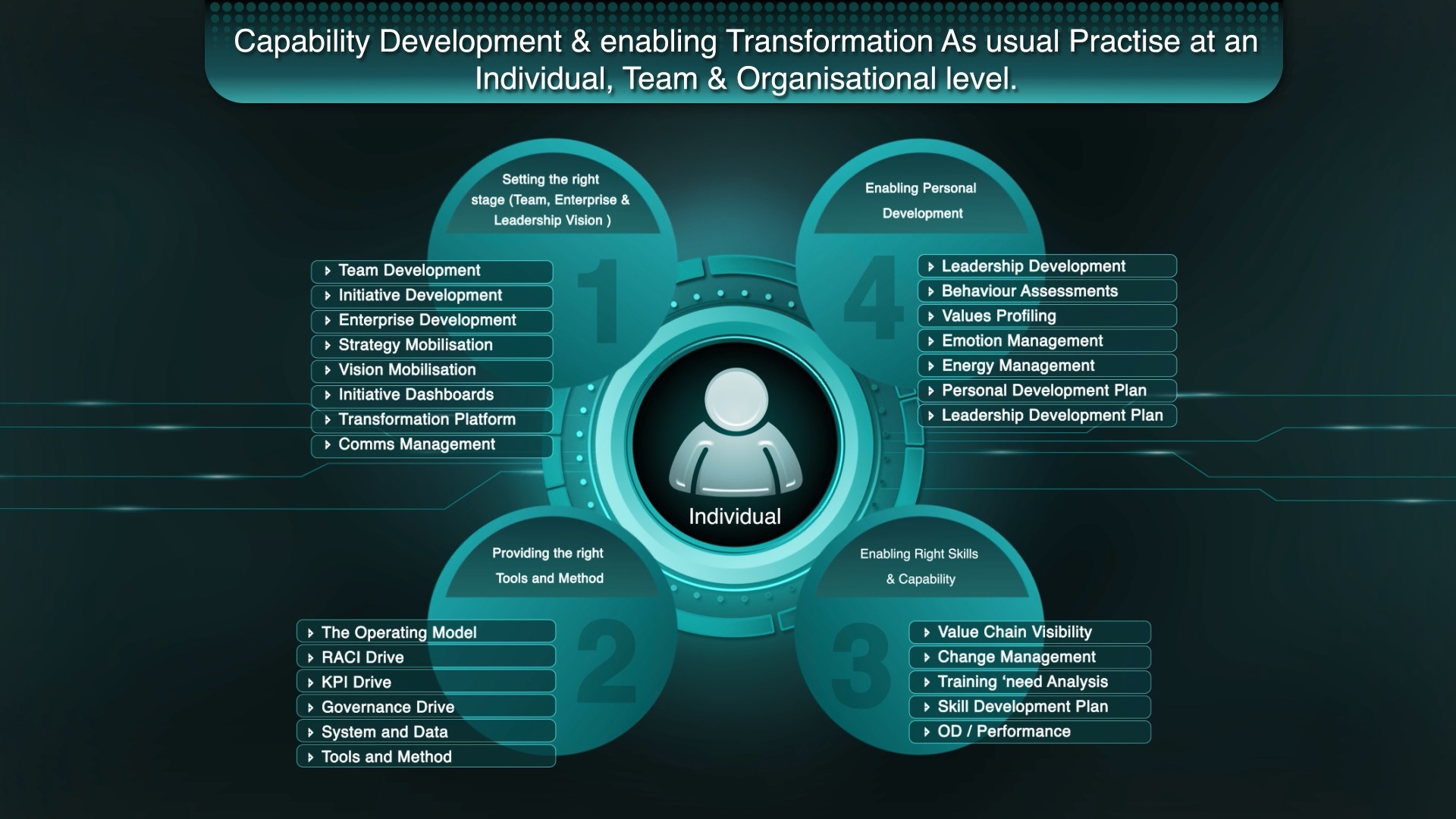Pharmaceutical – Enterprise Business Transformation
An Introduction To Our Pharmaceutical Platform
Modus Business Transformation Core Modules
Building, Driving and Sustaining your Business Transformation and embedding a 'Transformation As Usual' platform.
01 - Business Model Management - Manage and Adapt
Embrace the Business Model Management Hub to ensure your pharmaceutical enterprise remains at the forefront of the industry, driving sustainable growth and operational excellence.
Key Features:
• Business Model Management: Set up and analyze current and future
business models, focusing on markets, customers, products, and services to
drive growth and innovation.
• Business Transformation Survey: Evaluate organizational readiness and
identify areas for improvement to support strategic transformation initiatives.
• Transformation Strategy Hub: Develop and execute transformation
strategies that align with the overall business objectives and ensure
seamless implementation.
Benefits:
• Enhanced Innovation: Foster a culture of continuous improvement and
innovation.
• Increased Efficiency: Streamline processes and improve operational
efficiency.
• Competitive Advantage: Stay ahead of the competition by being agile and
responsive to market demands.
• Customer Focus: Better understand and meet customer needs through
tailored business models.
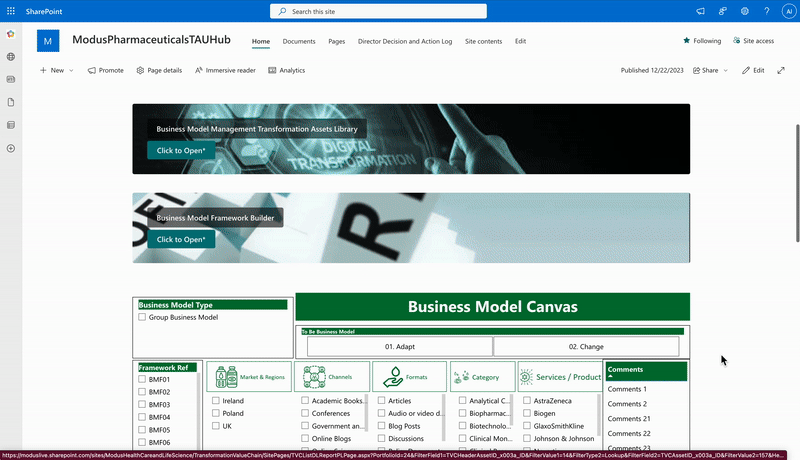
Why It's Important:
• Adaptability: Quickly adjust business models to respond to market changes
and new opportunities.
• Strategic Alignment: Ensure that all business activities are aligned with the
company's strategic vision.
• Informed Decisions: Leverage comprehensive analysis to make data-driven
decisions that enhance business performance.
• Holistic View: Gain a complete overview of the business landscape, enabling
proactive management of all critical elements.
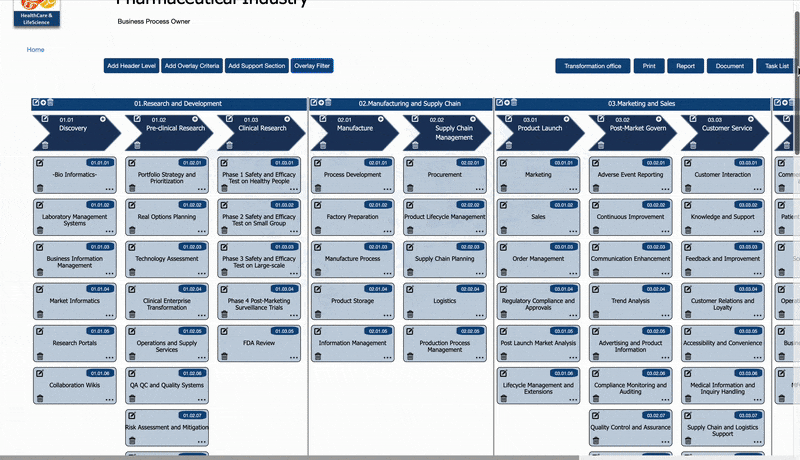
Benefits:
• Improved Efficiency: Streamline processes to reduce costs and improve
productivity.
• Informed Decision-Making: Use comprehensive data to make strategic,
informed decisions.
• Enhanced Coordination: Improve coordination across different departments
and functions.
• Sustainable Growth: Plan for long-term success with a clear, strategic
approach to business management.
02 - The Value Chain Modeler - Manage and Adapt
Harness the power of the Value Chain Modeler to optimize your pharmaceutical enterprise's operations, driving efficiency and growth while maintaining a competitive edge in the market.
Key Features:
• Value Chain Analysis: Gain detailed insights into each component of your
value chain to identify strengths, weaknesses, and opportunities for
improvement.
• Value Chain Surveys: Conduct surveys to evaluate the effectiveness of your
value chain and gather data-driven insights for strategic decisions.
• Target Operating Model: Develop a target operating model that aligns with
your business strategy and supports optimal performance across all
functions.
Why It's Important:
• Holistic View: Understand the full scope of your business operations and
interdependencies.
• Strategic Planning: Create robust plans that drive business growth and
efficiency.
• Optimization: Identify areas for improvement and implement changes that
enhance performance.
• Alignment: Ensure all parts of the business are working towards common
goals and objectives.
03 - The Operating Model - Organize and Sustain
Implement the Operating Model in Modus ETP to organize and sustain your pharmaceutical enterprise's operations, driving continuous improvement and maintaining a competitive edge.
The Operating Model in Modus ETP is designed to help pharmaceutical enterprises organize and sustain their operational processes and activities. It defines, captures, and visualizes these processes, creating a 'living' process knowledge hub known as the Ways Of Working Centre Of Excellence.
Key Features:
• TOM and Operating Model Design: Develop and refine your Target
Operating Model (TOM) to align with strategic goals.
• Operating Model Components: Manage all components of your operating
model, ensuring comprehensive coverage of operational activities.
• Product and Services Value System Design: Design a value system that
integrates products and services for maximum efficiency.
• Customer Experience Design (CX): Enhance customer experience by
designing processes that meet customer needs effectively.
• Business Role and Skill-Based Design: Define roles and required skills to
ensure the right capabilities are in place.
• Process Support Office: Establish a support office to maintain and update
process documentation and standards.
Why It's Important:
• Organizational Clarity: Provides a clear structure for all operational
processes and activities.
• Continuous Improvement: Acts as a living guide that evolves with your
business, ensuring processes remain up-to-date.
• Enhanced Training: Multiple operating models serve as ongoing training
guides, helping staff understand and adopt best practices.
• Strategic Alignment: Ensures that operational activities are aligned with the
business strategy and goals.
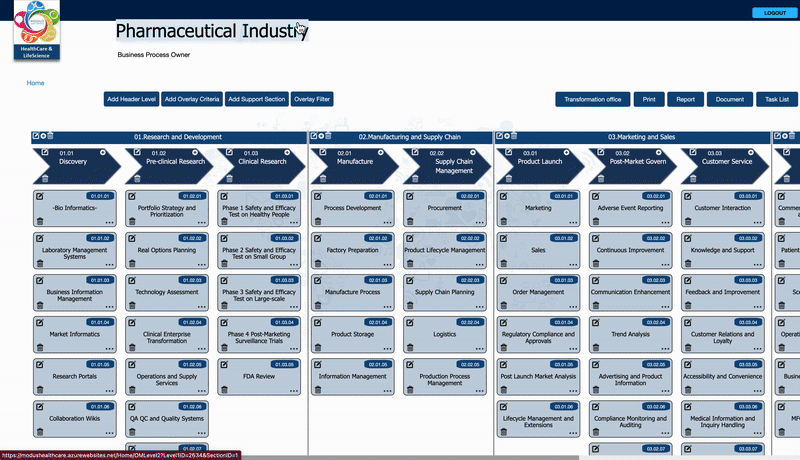
Benefits:
• Operational Excellence: Streamline processes for improved efficiency and
effectiveness.
• Sustained Knowledge: Maintain a central repository of process knowledge
that supports continuous learning and improvement.
• Improved Customer Experience: Design processes that enhance customer
satisfaction and loyalty.
• Role Clarity: Clearly define roles and skills to ensure all team members are
equipped to perform effectively.
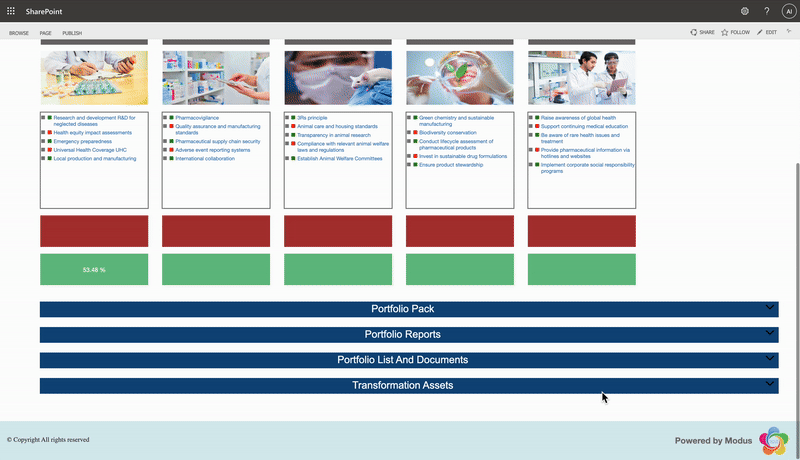
Benefits:
• Streamlined Processes: Pre-built templates accelerate regulatory
compliance and drug development workflows.
• Data-Driven Decisions: Provides tools to make informed choices in
research, production, and distribution.
• Consistency: Ensures uniform standards across pharmaceutical operations,
reducing errors.
• Adaptability: Customizable assets allow flexibility to meet evolving regulatory
and market demands.
04 - The Transformation Assets and Portfolio Module - Discover and Transform
Implementing the Transformation Assets and Portfolio Module in Modus ETP enables pharmaceutical enterprises to discover and transform effectively, ensuring strategic goals are met and sustained over time.
Key Features:
• Portfolio Management Office: Centralize portfolio management to oversee all
transformation initiatives.
• Pillar/Initiative Management Office: Manage specific pillars or initiatives
within the transformation portfolio.
• Program Management Office: Oversee and coordinate multiple related
projects to achieve strategic objectives.
• Project Management Office: Ensure successful project delivery with
standardized methods and practices.
• Project Support Office (Virtual PMO): Provide virtual support for project
management activities.
Why It's Important:
• Streamlined Transformation: Use a robust library of templates and methods
to simplify and accelerate transformation processes.
• Centralized Control: Maintain centralized oversight of all transformation
activities for better coordination and alignment.
• Effective Resource Utilization: Ensure optimal use of resources across all
transformation projects.
• Sustained Success: Support ongoing improvement and adaptation through
comprehensive review and governance.
• Value Chain Analysis
• Business Model Analysis
• Transformation Strategy
• Transformation Mobilisation
• Planning Management
• Transformation Log Management
• Financial Management
• Communication Management
• Operating Model Management
• Process Design Management
• IT Design Management
• Build and Test Management
• Implementation Management
• Change Management
• Personal Development Assessments
• Training Management
• Organizational Design Management
• Transformation Review
• Optimization and Governance
05 - Organizational Change Management - Unite and Thrive
Implementing the Organizational Change Management module in Modus ETP helps pharmaceutical enterprises unite their teams and thrive through successful change adoption and sustained organizational growth.
Key Features:
• Change Management Office: Centralize and coordinate change initiatives to
ensure seamless implementation.
• Comms Management Office: Manage communication strategies to keep all
stakeholders informed and engaged.
• Organizational Design Management Office: Design and implement effective
organizational structures.
• Leadership Development Practices: Foster leadership skills to guide and
sustain change efforts.
• Change Workbench: Utilize tools and frameworks to manage and monitor
change processes.
Why It's Important:
• Full Change Adoption: Ensure changes are fully adopted across the
organization.
• Effective Communication: Keep all stakeholders aligned and informed.
• Skill Development: Equip employees with the necessary skills to thrive in a
changing environment.
• Sustainable Growth: Foster a culture of continuous improvement and
adaptability.
• Leadership Empowerment: Develop strong leaders to drive and sustain
change initiatives.
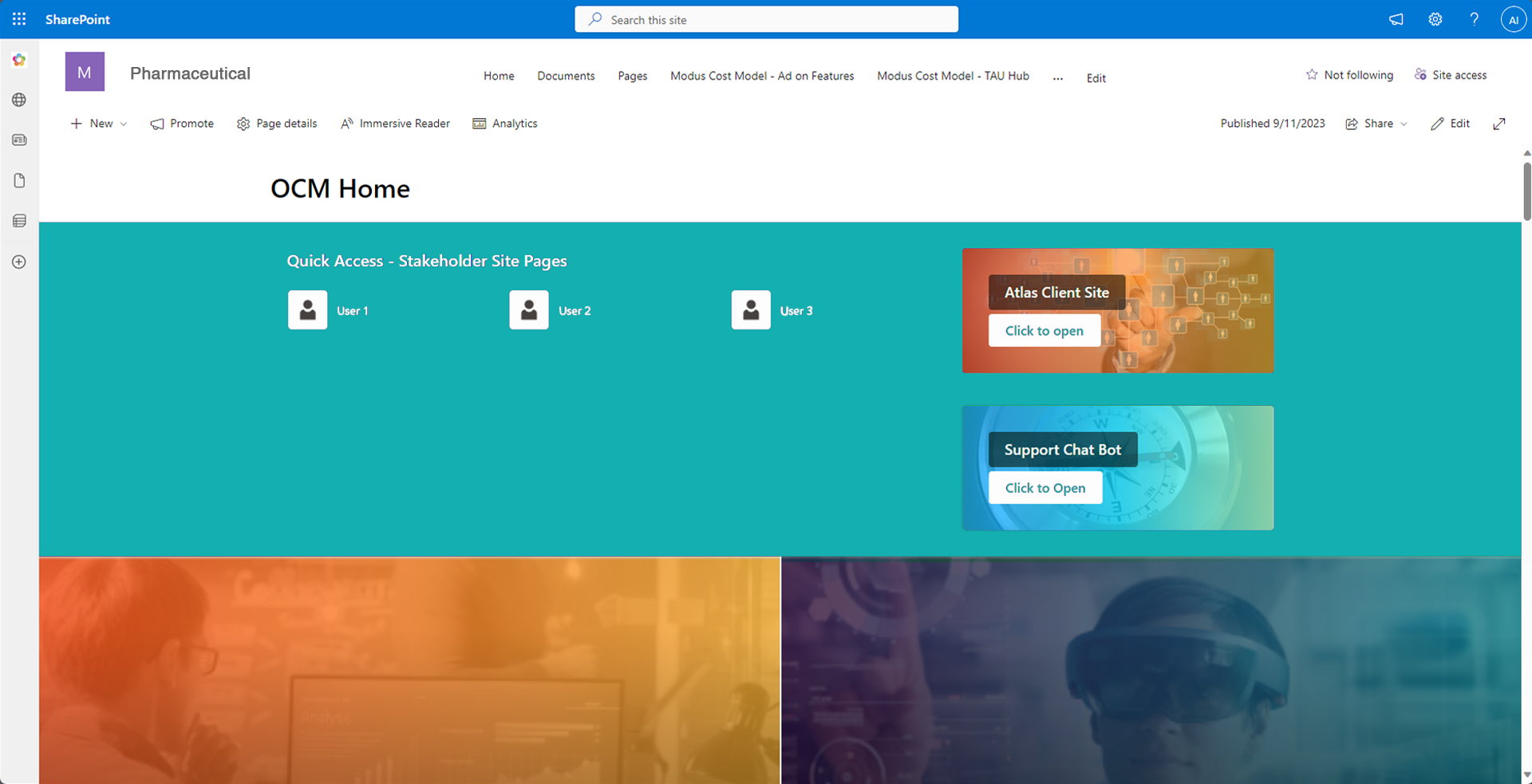
Benefits:
• Effective Change Implementation: Ensures smooth integration of new
processes and regulations in pharmaceutical operations.
• Regulatory Compliance: Helps align organizational changes with strict
industry standards and regulatory requirements.
• Increased Employee Buy-In: Engages staff through training and
communication, fostering acceptance of changes.
• Reduced Operational Disruptions: Manages transitions with minimal impact
on productivity and quality control.
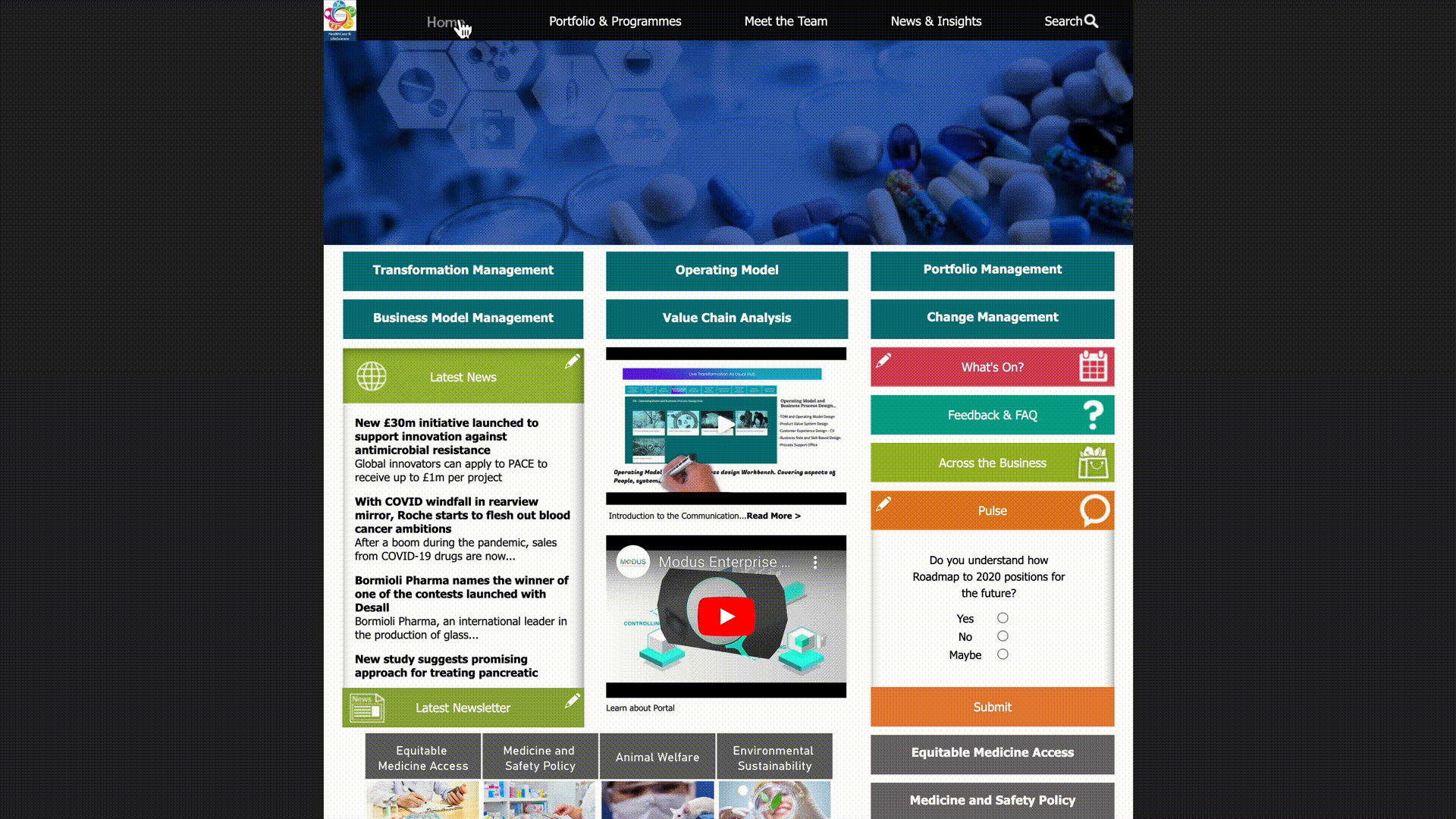
Benefits:
• Centralized Communication: Provides a single platform for all stakeholders
to access critical updates and project information.
• Improved Collaboration: Enhances coordination between teams,
departments, and external partners in pharmaceutical projects.
• Real-Time Monitoring: Enables instant tracking of progress, ensuring timely
adjustments in regulatory or R&D initiatives.
• Increased Stakeholder Engagement: Keeps employees, suppliers, and
regulators informed, boosting involvement and alignment with company
goals.
06 - Engagement Hub - Share and Guide
The Engagement Hub in Modus ETP is designed to centralize and streamline communication for pharmaceutical enterprises, fostering a collaborative environment that supports transformation and change initiatives.
Key Features:
• Centralize Transformation Comms: Consolidate all transformation
communications in one place for easy access.
• Latest News: Stay updated with the latest developments and news related to
transformation projects.
• Poll Surveys: Conduct surveys to gather feedback and insights from team
members.
• Transformation Team Areas: Dedicated spaces for transformation teams to
collaborate and share information.
• Business Team Areas: Provide business teams with areas to coordinate and
align with transformation efforts.
• Calendar Roadmaps: Access detailed roadmaps and schedules to track
transformation milestones.
Why It's Important:
• Enhanced Communication: Ensure all team members are informed and
aligned with transformation goals.
• Collaboration: Facilitate effective collaboration across different teams and
departments.
• Transparency: Provide visibility into transformation activities and progress.
• Feedback Mechanism: Use surveys to capture valuable feedback and drive
continuous improvement.
• Global Reach: Engage a diverse workforce with multi-language support.
Transformation As Usual Capability Model
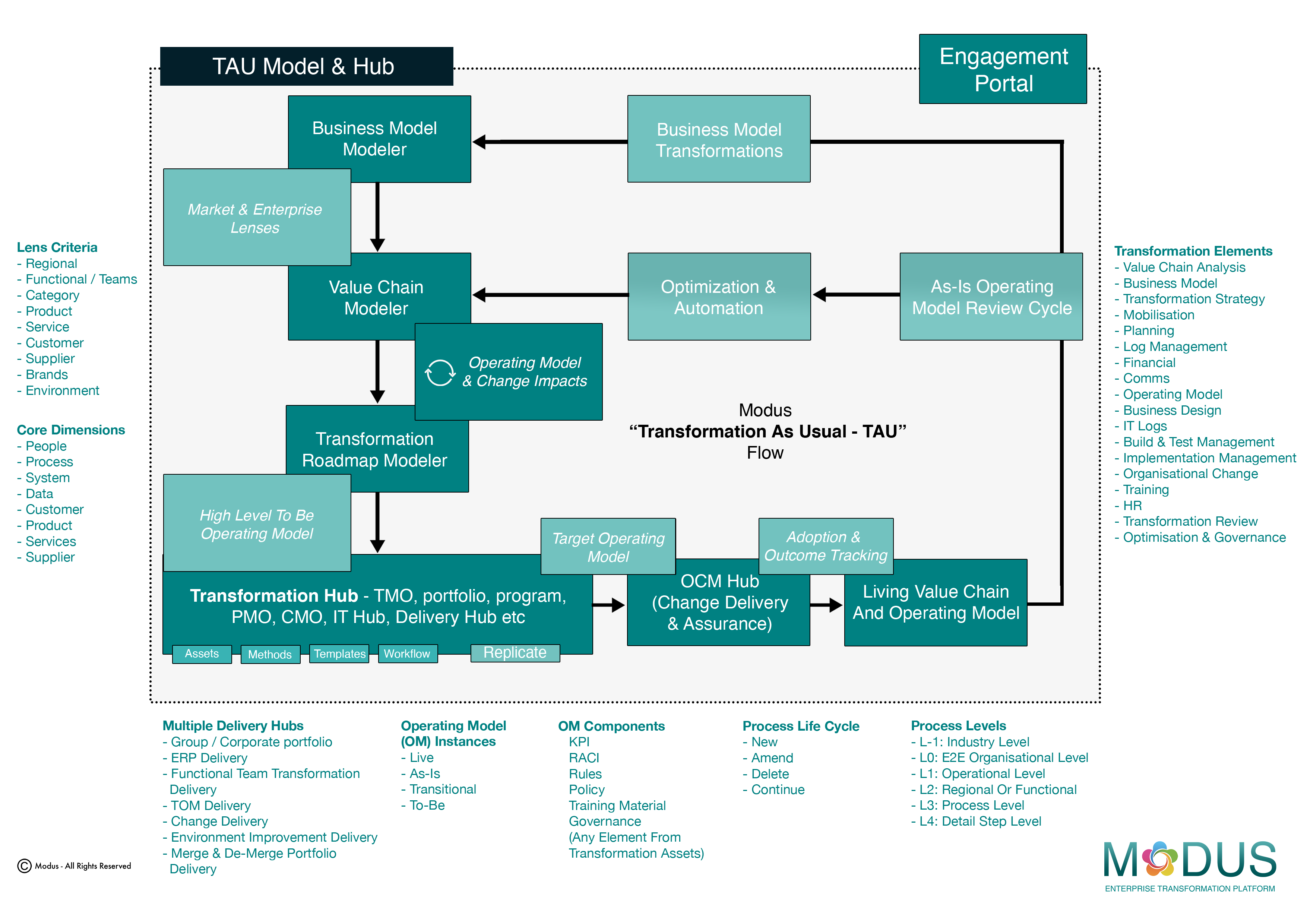
Individual and Team Capability Development
